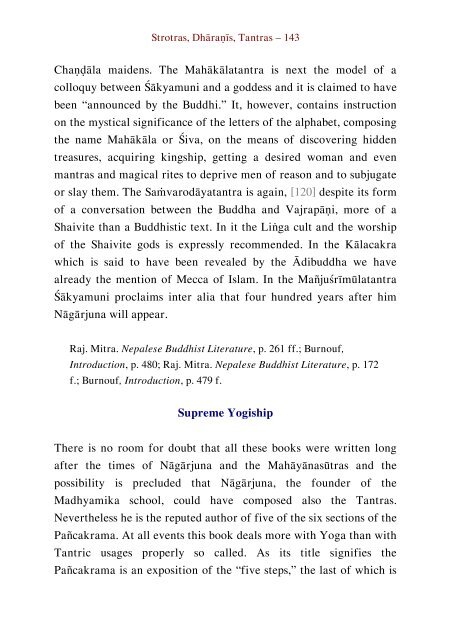Literary History of Sanskrit Buddhism
A study by J. K. Nariman of Sanskrit Buddhism from the Early Buddhist Tradition up to the Mahayana texts proper.
A study by J. K. Nariman of Sanskrit Buddhism from the Early Buddhist Tradition up to the Mahayana texts proper.
Create successful ePaper yourself
Turn your PDF publications into a flip-book with our unique Google optimized e-Paper software.
Strotras, Dhāraṇīs, Tantras – 143<br />
Chaṇḍāla maidens. The Mahākālatantra is next the model <strong>of</strong> a<br />
colloquy between Śākyamuni and a goddess and it is claimed to have<br />
been “announced by the Buddhi.” It, however, contains instruction<br />
on the mystical significance <strong>of</strong> the letters <strong>of</strong> the alphabet, composing<br />
the name Mahākāla or Śiva, on the means <strong>of</strong> discovering hidden<br />
treasures, acquiring kingship, getting a desired woman and even<br />
mantras and magical rites to deprive men <strong>of</strong> reason and to subjugate<br />
or slay them. The Saṁvarodāyatantra is again, [120] despite its form<br />
<strong>of</strong> a conversation between the Buddha and Vajrapāṇi, more <strong>of</strong> a<br />
Shaivite than a Buddhistic text. In it the Liṅga cult and the worship<br />
<strong>of</strong> the Shaivite gods is expressly recommended. In the Kālacakra<br />
which is said to have been revealed by the Ādibuddha we have<br />
already the mention <strong>of</strong> Mecca <strong>of</strong> Islam. In the Mañjuśrīmūlatantra<br />
Śākyamuni proclaims inter alia that four hundred years after him<br />
Nāgārjuna will appear.<br />
Raj. Mitra. Nepalese Buddhist Literature, p. 261 ff.; Burnouf,<br />
Introduction, p. 480; Raj. Mitra. Nepalese Buddhist Literature, p. 172<br />
f.; Burnouf, Introduction, p. 479 f.<br />
Supreme Yogiship<br />
There is no room for doubt that all these books were written long<br />
after the times <strong>of</strong> Nāgārjuna and the Mahāyānasūtras and the<br />
possibility is precluded that Nāgārjuna, the founder <strong>of</strong> the<br />
Madhyamika school, could have composed also the Tantras.<br />
Nevertheless he is the reputed author <strong>of</strong> five <strong>of</strong> the six sections <strong>of</strong> the<br />
Pañcakrama. At all events this book deals more with Yoga than with<br />
Tantric usages properly so called. As its title signifies the<br />
Pañcakrama is an exposition <strong>of</strong> the “five steps,” the last <strong>of</strong> which is


















